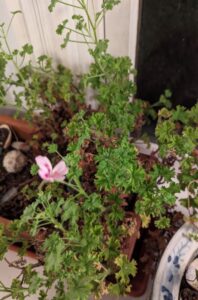Now that the holidays have passed, the scents of fir and pine are behind us and a long winter of indoor living is still ahead. If you are lucky, the winter smells in your house include the aromas of delicious things in the oven and wood burning in the fireplace. If you are less lucky, you will be wrinkling your nose at smells like wet wool, wet dogs and the various rank odors emanating from the kitchen trash can.
This is why I am dreaming of masses of scented geraniums. These dreams are enhanced by the plant catalogs that started arriving about December 15, and will continue landing in the mailbox daily until the onslaught reaches avalanche level in March. As I page through print catalogs and scroll through online vendors, I can almost smell the fragrant leaves of varieties like ‘True Rose’ and ‘Grey Lady Plymouth’. It will take steely self discipline and daily perusal of my checking account balance to prevent massive orders.
Scented geraniums are part of the Pelargonium genus, just like the red, white or pink window box or bedding geraniums that we will all be buying a few months from now. Unlike those plants, the scented specimens are somewhat less floriferous. In place of the big fluffy flowerheads common to the bedding geraniums, scented species, varieties and hybrids generally feature more delicate flowers. The attraction is the leaves, which, when brushed or crushed between fingertips exude fragrances that may be floral, fruity, minty, evergreen or spice-scented. Some, like ‘Chocolate Peppermint’ offer a combination of scents. Others bear fragrances that are sweet, but somewhat indeterminate. Probably the most famous scented geranium is ‘Citronella’ or Pelargonium citrosa, with lemon-scented leaves that may, when rubbed on the skin, repel mosquitoes.
Scented leaves are an evolutionary adaptation that enables the plants to repel predators. This is a definite plus for modern-day gardeners, because deer and other varmints will not eat them. With foliage that varies from the small, frilly leaves of lemon-scented Pelargonium crispum, to the large, soft, maple-like leaves of Pelargonium tomentosum varieties like ‘Peppermint’, scented geraniums offer something for every gardener with a little sunny space. Since most scented geraniums are tender in cold winter climates, they also make excellent container subjects and are happy overwintering in sunny windows.
The spotlight of horticultural fashion has not always shone brightly on scented geraniums, but they are having a moment right now. The Select Seeds catalog, a mainstream seed and plant merchant specializing in heirloom varieties, features 11 different scented geraniums. The Geraniaceae website, a specialist vendor, lists a whopping 141 varieties, and Well-Sweep Herb Farm carries scores of scented types. There are so many scented varieties available that the only challenge is choosing among them.
I love lemon scents, so I am partial to Pelargonium crispum types with strong citrus fragrance. The hybrid, ‘Limona’ bears pink flowers splashed with darker pink, parsley-like green leaves and a relatively low, 1.5 foot growth habit. I always grow it in containers near the back door. The graveolens species yields rose-scented varieties, including my favorites, ‘True Rose’, with deeply dissected leaves and strong fragrance, and ‘Grey Lady Plymouth’, an heirloom variety with gorgeous grey-green leaves edged in cream, and pink flowers.
A few years ago I was trolling the aisles at a small rural nursery when I encountered a pallet of scented geraniums. One was labeled “Pelargonium x fragrans—Nutmeg-scented geranium”. I held it up to my nose and, true to the name, the soft lobed leaves yielded a pronounced nutmeg smell. It was a revelation.
Scented geraniums, especially the citrus, fruit and floral varieties have long been used in cooking. Susan Conder’s wonderful book, The Complete Geranium, features some excellent recipes, including Lemon Geranium Cake, flavored with both lemon rind and lemon geranium leaves, and decorated with additional crystallized leaves. Another recipe, for Rose Geranium Ice Cream, uses cream infused with rose geranium leaves. Non-cooks can also dry scented geranium leaves for use in potpourri.
Pelargoniums, including the scented types, are not fussy plants. They prefer direct sun, well-drained soil and supplemental moisture when the top of the soil is dry. Feed with a balanced plant food, applied according to manufacturers’ directions, during spring and summer
Sometimes you can buy scented geraniums at local nurseries in the spring, but the best selections are found online. Try one or all of the following: Select Seeds, 180 Stickney Hill Road, Union, CT 06076, (800) 684-0395, www.selectseeds.com; Geraniaceae, at www.geraniaceae.com; or Well-Sweep Herb Farm, 205 Mt Bethel Rd, Port Murray, NJ 07865, (908) 852-5390, www.wellsweep.com. Select Seeds offers a print catalog. Well-Sweep offers a downloadable plant list.

